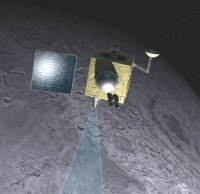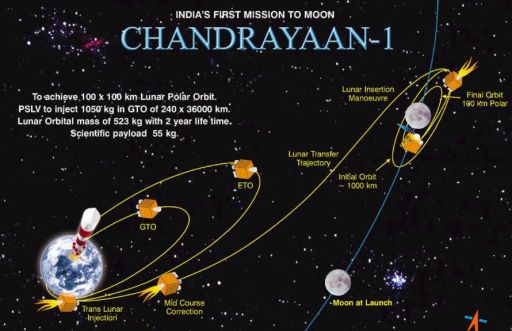Chandrayaan-1 has two general goals: Map the lunar surface features from space and observe the presence of radioactive isotopes to help researchers determine the origins of the Moon Successfully build up and maintain ground support systems, communications systems, and data reception and interpretation systems. In addition, this mission will prove the increasing technical and scientific capabilities of India.
Additionally, there are specific parts of the Moon that the science instruments will focus on : The permanently shadowed north and south polar regions areas where there may be ice, especially at the poles highland rocks central upland large lunar craters, where there is probably exposed interior material height variation of lunar features X-ray coverage of most of the Moon's surface.
Mission Timeline :
Launch date: October 22 at 00:52 UTC
Lunar orbit insertion: November 8 at 11:21 UTC
Nominal mission: two years
Spacecraft : Cube shape, with a length of 1.5 meters on each side and a total mass of 1,050 kilograms (523 kilograms initial orbit mass and 440 kilograms dry mass). The satellite design is based on ISRO's Kalpansat meteorological satellite that was launched in 2002. Chandrayaan-1 will also carry a 30-kilogram probe that will penetrate the surface of the Moon.
A 750-Watt solar panel together with a Lithium-Ion battery will supply power to the spacecraft. A bipropellant engine will be used to enter orbit and to maintain the spacecraft's orbit at the Moon. The total mission cost is INR 3.8 billion (US $83 million)
Orbit : Chandrayaan 1 will be launched from the Satish Dhawan Space Center in Sriharikota, on a PSLV (Polar Satellite Launch Vehicle) rocket. After a five-and-a-half-day 240 by 36,000 kilometer geotransfer orbit, it will end up in a 1,000-kilometer (600-mile) orbit around the Moon. From there, it will drop to a checkout orbit of only 200 kilometers (120 miles) and then a final orbit 100 kilometers (60 miles) from the surface of the Moon, where it will orbit for about two years.
Chandrayan Instruments : Chandrayaan-1 will have instruments that allow the remote sensing of visible, near infrared, soft and hard X-ray, and low-energy gamma ray wavelengths on the surface of the Moon. The total mass of the instruments is 55 kilograms. Some of the instruments will be supplied or supported by NASA and ESA, including some spare instruments from SMART-1.
The Terrain Mapping Camera (TMC) is a panchromatic stereo camera with a 5-meter resolution and a 40-kilometer swath width. It will be used to make a high-resolution atlas of the Moon's surface.
The HYper Spectral Image (HySI) is a camera that can make observations in the 400 to 900 nanometer band with a spectral resolution of 15 nanometers and a resolution of 80 meters on the ground. It will make mineralogical maps of Moon's surface.
The Lunar Laser Ranging Instrument (LLRI) will take elevation measurements of the Moon's surface with a resolution of 10 meters. It will be used to make a topographic map of the Moon's surface.
The High Energy X-ray/Gamma-ray Detector (HEX) will observe X-rays and Gamma rays from 10 to 200 kiloelectron volts. It will be used to measure and detect very heavy radioactive isotopes on the Moon such as 210Pb, 222Rn degassing, uranium, thorium, etc. It has a ground spatial resolution of 18 kilometers and is built with the help of ESA.
The Chandrayaan-1 Imaging X-Ray Spectrometer (CIXS-2) will observe X-rays and Gamma rays from 0.5 to 10 kiloelectron volts. It will be used to detect and measure light radioactive isotopes such as silicon, aluminum, magnesium, calcium, iron, and titanium. It is a copy of the same instrument on ESA's SMART-1, built by the UK with ESA.
The Solar X-Ray Monitor (SXM) will measure X-ray flux from the Sun in the range from 2 to 10 kiloelectron volts, using it to calibrate the CIXS-2 by taking solar radiation into account. It is also copy of the same instrument on SMART-1.
TheMiniature-Synthetic Aperture Radar (Mini-SAR) will look for material with "unusual scattering properties" on the surface of the Moon that would imply the existence of ice, a resource that could be used to support possible future manned lunar bases. A similar device may be deployed on the NASA's Lunar Reconnaissance Orbiter, so the two devices could be used together for bistatic imaging. The mini-SAR is manufactured by NASA.
The Sub keV Atom Reflecting Analyser (SARA) will observe particles from the Moon's surface that have been knocked off by solar wind and will also measure the Moon's magnetic field. It is built by Sweden with ESA.
The Near-Infrared Spectrometer (SIR-2) will observe near-infrared light in wavelengths from 900 to 2.400 nanometers. This will determine the mineralogical makeup of the surface of the Moon. It is a copy of the same instrument on SMART-1, built by Germany with ESA.
The Moon Mineralogy Mapper (M3) can be used to make observations in the 700 to 3,000 nanometer range with a resolution if 10 nanometers. In Targeted Mode, it has a ground resolution of 63 nanometers and 125-meter resolution in Global Mode. It is manufactured by NASA.

